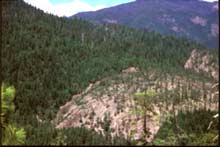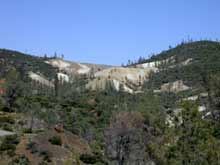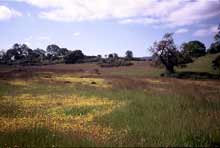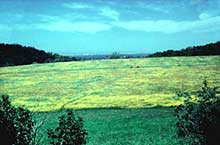|

May 15, 2008
Watching the movie There Will Be Blood (for which Daniel Day-Lewis won the overacting Oscar), I noticed the setting more than I usually do. In tune with the film’s flaunting of grimness, it was not picturesque. I saw a rugged, dry, stony landscape of sparse vegetation, and heard characters complaining that no crops would grow there. I thought, I bet that’s serpentine!
I’d probably lose the bet. I checked: there are serpentine landscapes and life-forms in Texas—some of them even associated with oil—but not, as far as I could tell, around Marfa, Presidio County, in the West Texas panhandle, where the movie was filmed. But “serpentine” was not a concept I even had in my mind a couple of months ago, before working on Susan P. Harrison and Arthur R. Kruckeberg’s May article, “Garden on the Rocks.”
 |
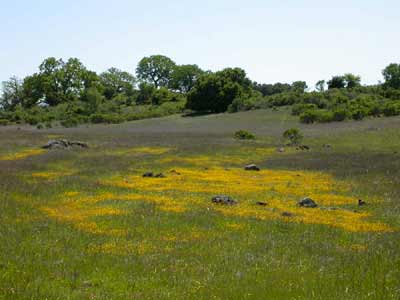

Lasthenia californica growing on the serpentine grassland at Jasper Ridge Biological Preserve, Stanford University. Oaks in the background are growing on sandstone. |
|
 |
The authors put this unique type of rock and soil on the map for me, and I’m sure for many readers, coloring in what we hadn’t even known was a blank spot in our picture of the world.
The authors explained that serpentine rocks, the soils worn from them, and the plant communities that live in those soils are strikingly different from all that surrounds them—so much so that a clear borderline can often be seen. That’s because serpentine derives from the magnesium (Ma)- and iron (Fe)-rich “ultramafic” rocks (easy name to remember—they’re the very Mafiosi of minerals) of the earth’s mantle rather than from the calcium- and phosphorus-rich crustal rocks and soils that dominate Earth’s surface. Mantle rock stuck to the underside of bits of new, spreading ocean crust that got scraped off on the continental margin when plates collided, or subducted and later upthrust in mountain formation. In either case the alkaline ultramafics got exposed to water, which turns them to serpentine in a chemical reaction so volatile that it powers certain ocean vents and may even have played a role in the origin of life. (Hmmm, a serpent plays a key role in many of humanity’s oldest creation myths. But the only real connection between serpentine and snakes is its predominant greenish color and sometimes scaly texture—enough to inspire the ancients to use powdered serpentine as a snakebite remedy.)
But Harrison and Kruckeberg told you all about serpentine; I want to tell you about them, especially about botanist Arthur Kruckeberg, a University of Washington emeritus professor now in his late 80s, who has devoted much of his long scientific life to elucidating the mysteries of serpentine (when he wasn’t gardening or playing the bassoon) and getting younger researchers like Harrison hooked on them (PDF, see page 6). What draws a budding scientist to his or her subject? That’s a fascinating question that can only be answered by stories—it must be some combination of chemistry, chance, fate, and a Pied Piper of a teacher—but once that fateful bond has been forged, the subject gives the scientist a career, and in turn she or he becomes, in a sense, the representative and spokesperson of that organism, ecosystem, or phenomenon, its ambassador to the human world. Because of Art Kruckeberg and the tight-knit community of specialists studying it, serpentine has a voice for us; it isn’t silent and invisible. That both adds another rich strand to the tapestry of human culture (bringing it that much closer to the infinite richness of nature) and makes it likelier that serpentine’s own interests will be looked after—that serpentine ecosystems, dismissed in the nineteenth century as “wastes,” may be appreciated and protected.
 |
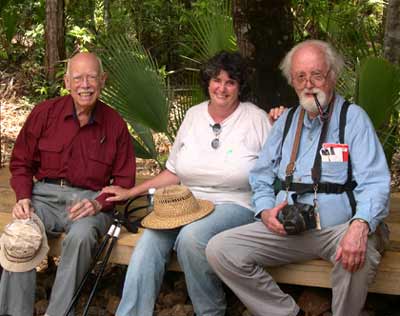

Colleague from U of Washington and fellow-serpentinophile Dick Walker,
Cuban serpentinophile Rosalina Berazaín Iturralde, and Art Kruckeberg
in Cuba 2004 |
|
 |
(A narrower legal version of this notion was put forth, with mixed success, by legal scholar Christopher D. Stone in his landmark 1972 essay, Should Trees Have Standing?)
There appears to be a lot of joy and fun and collegiality (and undoubtedly all the other human stuff, like romance, feuds, and rivalry) in living that role. On the occasion of Dr. Kruckeberg’s 80th birthday, in 2000—and the tenth anniversary of his official retirement (unofficially no such thing, of course)—other members of the serpentine science tribe wrote biographical sketches, tributes and reminiscences in three successive issues of a newsletter called Botanical Electronic News (BEN). You can read them here, here, and here: they are a delightful peek into the long life of a dedicated scientist and into the goings-on at the human-serpentine interface. (The third one features an intriguing digression, by way of Dr. Kruckeberg’s bassoon playing, into the ethnobotany of Arundo donax, a “mysterious grass that grows in the marshes of France” and is the source of woodwind reeds—but when transplanted to California loses its mojo and is merely a pest.) A former student recalls the power of a great teacher to channel a calling:
Rhoda Love: At the University of Washington it was Fall term, 1950. I was an 18-year-old freshman English major. My advisor examined my high school transcript and recommended I get science over with by enrolling in a General Biology course being team-taught by various members of the science faculty. The first term was taught by A. R. Kruckeberg. It was an enormous lecture section offered in a huge sloping room on the first floor of Johnson Hall. . . . On the podium far below Art held forth. I found him a fascinating presence. Tall and skinny, with a handsome profile and somewhat imperious manner, he tended to pontificate a bit, but in a riveting style making use of his legendary vocabulary. I fell under his spell. . . .

[Art] was fresh from graduate school at Berkeley, and before that some prestigious branch of the military [another contributor says he served as a language officer in the occupation of Japan]. His vast intellect and enthusiasm for his subject were spell-binding and I began to become a biologist. I found it interesting that he was apparently not at all concerned with matters sartorial. I seem to recall a bony elbow visible though the frayed arm of an old sweater. . . . I began to spend less time studying Lord Jim and Tess of the D’Urbervilles and more time on biology. When I received a most encouraging mid-term report from Art my mind was made up: it would be more science for me.
One contributor after another thanks Art Kruckeberg for channeling the siren voice of serpentine, the once-unloved, unbeautiful orphan landscape which has so richly rewarded human attention:
Robert G. Coleman: Professor Art Kruckeberg’s romance with serpentine has made geologists realize that vegetation supported by this unique substrate has a unique evolutionary history of survival in a very hostile environment. Art has been a leader among a group of botanists-biologists-chemists-geologists-pedologists that are enhancing our knowledge of the strange flora found growing on “serpentines.” . . . Recognition of the biotic and abiotic uniqueness of peridotite-serpentine tracts has prompted a worldwide agenda to preserve them as ecological islands of great scientific value.

Nishanta Rajakaruna: May his dedication and love for the world of serpentine inspire many others like myself, now and for many more years to come.
More than you ever dreamed there was to know about serpentine: here.
And all you new and inveterate serpentinophiles, heads up—there will be a major gathering of the tribe next month:
Serpentine Ecology Conference 2008

JUNE 16–23 2008
COLLEGE OF THE ATLANTIC
BAR HARBOR, ME 04609, USA

The Sixth International Conference on Serpentine Ecology will be held on the campus of the College of the Atlantic in Bar Harbor, located on Mount Desert Island on the rocky coast of Maine. The Conference provides an opportunity for the gathering of serpentinophiles from around the world, every 2-4 years, to share and discuss their findings relating to the broad and inter-disciplinary field of serpentine ecology. . . .

Topics discussed at the Conference range from botany to geology and illustrate how unusual geologies generate and maintain biodiversity. Participants include botanists, zoologists, ecologists, pedologists, geologists, microbiologists, evolutionary geneticists and conservation biologists. Many attendees work across disciplines to explore the fascinating relationships that exist between extreme habitats and life. . . .
More information, full program, and registration forms at the above link.


(Annie Gottlieb) |
Comments (add yours!)

Return to May home
|


